|
|
|
|||
|
|
||||
|
|
||||
| The (Jet)X Files | ||||
|
|
HOME | SITE MAP | FORUM | CONTACT |
|
||
|
ABOUT | MOTORS | MODELS | ARCHIVE | HISTORY | STORE | FAQ | LINKS
|
|
|
|
|
|
||||||||||||||||||||||||||||||||||||||||||||
|
The (Jet)X Files 14
for February 2004
by Roger Simmonds Reprinted from SAM 35 Speaks, February 2004 Feedback ‘Feedback’ has become a regular feature of this column, but I am somewhat dissatisfied with the expression. I had thought of using “Jet Reaction”, but this was the title of Terry Kidd’s column. ‘Afterburning’ is a possible and appropriate heading, but any better suggestions would be very welcome. Two columns ago I quoted Terry Kidd’s comment about ROW (rise off water) Jetex models. Peter Cock had a model at Wilmot Mansour & Co. in the early fifties that could not only rise off water, but also rise off (from) underwater (RUW). He says: “The trouble with boat planes was getting them off the water, the trouble with the ‘Jetex Hydroplane’ was keeping it on the water. So we attached wings and tail to a hydroplane and launched it off the pond at Southampton Common. It would skip across the water; as the pellet burned thrust increased and it would do aerobatics, ending in a dive into the water. The motor continued under water, if a bit slower, and it (the model) would suddenly reappear at a different part of the pond and take off again!” |
|
||||||||||||||||||||||||||||||||||||||||||||
|
With respect to scary rocket motors (see last month’s offering), Peter tells of a Jetex motor developed as a possible powerplant for the large LSARA glider [right]: “It was about the size of a starter motor for a big car. I remember a test run of this thing. They buried it in a big mound of earth and left about four inches of fuse hanging out. Somebody handed me a box of matches and said, “Err, Peter, go and light the fuse”. The others were all miles away hiding behind mounds of earth. Well, this thing was really frightening. It started with a faint whistle and a small plume of smoke and the whistle got louder and louder till it got to an ear-splitting screech and the mound surrounding it was all steaming. I was fully expecting it to explode any moment, but it didn’t and it burned itself out quite safely. The jet was on a neck, a tube about six inches long with a nozzle at the end. This tube got practically white hot”. I don’t think this motor was ever used in a model. Jetex and Rapier Performance Greg Baker has taken me to task for implying that the Jetex 50B was more powerful than the original ribbed 50, and confusing the output of the 50B with that of the later 50C. Greg rightly avers that neither the advertisements nor R.H. Warring’s test results (comprehensively summarised in the 1954 Aeromodeller Annual) claim any increase in thrust. Some of these data, which uniquely included BHP equivalents at 30 mph and 60 mph, are shown in the table below. Thrusts are given in both ounces and milliNewtons (mN).
I think we can assume these results were achieved with properly maintained motors and unblemished fuel. In practice, nozzles could become corroded if you weren’t careful and pellets absorbed moisture (it was a good idea to store pellets in an airing cupboard, and experts would even warm them carefully over a convection heater before use). Consequently, thrusts tended to be lower and more variable than the figures suggest. The later ‘Red Spot’ pellets for the larger motors gave more thrust, but I don’t think there was ever a ‘Red Spot’ fuel for the 50 size. The later Sebel fuel burned hotter and produced more thrust, and the 50C could deliver 3/4 ounce (210mN) towards the end of its run. |
 |
||||||||||||||||||||||||||||||||||||||||||||
|
Rapier motors deliver the following thrusts: original L2, 90-105 mN; Current L2, 110-140 mN; |
 |
||||||||||||||||||||||||||||||||||||||||||||
|
The supply situation is fortunately a lot easier here in the UK, and it is possible to build up a stock of Rapier motors of different specifications to suit different models by assiduously importuning suppliers and buying appropriate batches when one can. I store boxes of motors in a sealed tin with silica gel, and I might even pop them in the airing cupboard a day or so before flying. I keep fuses separately in an old Jetex wick tin and use only half each time. I try to keep motors in their correct boxes (where specifications are indicated on the side) in my flight bag. The odd loose motor does occasionally escape, and these I use in my Fairey Delta 2 [right], which relishes the occasional, if unintended, The L4 (which is physically bigger than the L2) is on paper a little less powerful than a Jetex 100, but in practice it will propel Jetex 100/Jetmaster/PAA-Loader designs quite adequately, and Ian Dowsett had an L4 powered |

- photo by Roger Simmonds
|
||||||||||||||||||||||||||||||||||||||||||||

The L4 will definitely overpower the ‘Flying Scale’ Jetex 50 models, so resist the temptation to fit one in that antique jet from the loft. It really is best to trim models with the lowest rated motor that is feasible, so start with an L2 and then, if necessary, try an |
|

KeilKraft Star-Jet (detail)
- Ian Dowsett
|
|||||||||||||||||||||||||||||||||||||||||||
|
The original L1 and L2 motors were less powerful than later versions and it made sense to reduce the classic Jetex 50 designs to 85-90% of the original for the first generation L2s. This is now not necessary, unless one wishes to use an Jet Records Talking of meetings, there is now a new hazard for the flier. It would seem that one had only to light a fuse at Old Warden and elsewhere this year for at least two ‘camcorders’ to be pointed in one’s direction. Graham Potter and Mike Stuart in particular are guilty of this potentially disastrous activity, though it must be admitted it is (a) only off-putting if you or the model know it is happening, (b) revealing of how shocking flyers’ language can be and so help us to mend our ways. SAMS Models has a video CD on offer with some Rapier action, and Mike Stuart has also been surreptitiously giving out CDs. I have been surprised at the good quality of some of the footage, and how enjoyable and addictive it is to reprise the good flights. Being of a scientific frame of mind, I wondered if one could learn from the recordings of the disasters and modify one’s launching and trimming techniques to achieve greater success. Sometimes the launch seems to have little bearing on the model’s subsequent trajectory, but a gentle launch at near flying speed seems to give best results with my models, whilst other models like a good chuck. Certainly, a lesson is, ‘there is no substitute for altitude’, and perhaps we should look again at catapult or bungee launching so that the model has some height before the motor cuts in. These techniques used to be quite popular, but nowadays few people seem to employ them. A video record of all trimming flights and the model’s responses to small changes in trim would be useful, but the ad hoc recordings I have seen so far are not comprehensive enough to indicate why a KK Swift is behaving so badly, or why that launch, whether the Pete Smart ‘stab’ or the Blackwell pirouette, worked and that one didn’t. Still, the recordings are very entertaining and even inspirational, and can reveal what you really want to build next, or even what designs to avoid. Vintage |
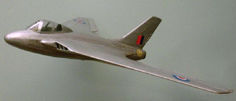
- photo by Roger Simmonds
|
||||||||||||||||||||||||||||||||||||||||||||
My discussion of Jetex free flight designs generated some correspondence. Though most of the ‘later’ duration designs are uninteresting, the earliest models from Wilmot Mansour (WM) and Veron (for example the Air-O-Jet) are delightfully individual. Mike Ingram has plans for the WM Dura-Jet and MiJet, but the somewhat inelegantly named 200 Contest Model, which appeared in 1951 at the same time as the Zyra Spacecraft, has been more elusive, and not even Ian Dowsett, the designer, had a plan. Fortunately David Carpenter has managed to exhume one from an original kit. This sacred relic, which was as brown and fragile as a fragment of a Dead Sea Scroll, is now bequeathed to Ian for retracing in his scriptorium. I still have a usable pre-production plan, so please let me know if you would like to try one.
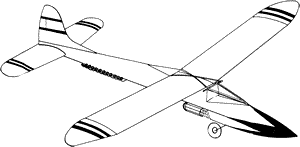 The model is quite large at 29", and will need to be reduced to about 80% (22"-23" span) for an L4, but it is a practicable design, as nice in its way as the contemporary Veron designs. The illustration on the right is taken from the original plan. Note the dethermaliser.
The model is quite large at 29", and will need to be reduced to about 80% (22"-23" span) for an L4, but it is a practicable design, as nice in its way as the contemporary Veron designs. The illustration on the right is taken from the original plan. Note the dethermaliser. |
 |
||||||||||||||||||||||||||||||||||||||||||||
|
Here we go round again It is not uncommon for a columnist to send off his latest masterpiece to the editor, and then come across some wonderful material that should have been included in the article. So it is that this month I have four new items about round the pole (RTP) models. First, here is a nicer illustration [right] of Joe Mansour’s RTP demonstrator that better reveals its elegant lines and similarity to Roswell Brown’s contemporary Strato-Rocket. I wonder if it had a name and if there is a contemporary plan, can any reader help? Secondly, I found a very nice SAAB J29 in Teknik för alla, Sep. 1954 [below]. This Jetmaster powered model shares many design features with Darnell’s Mystère, including ‘solid’ construction and a motor that is a very tight fit in the fuselage. This exhausts into a narrow flared orifice, which can have done little for its efficiency. An L4 will give more room in the fuselage and allow for a cooling airflow, but the jet pipe will need enlarging. 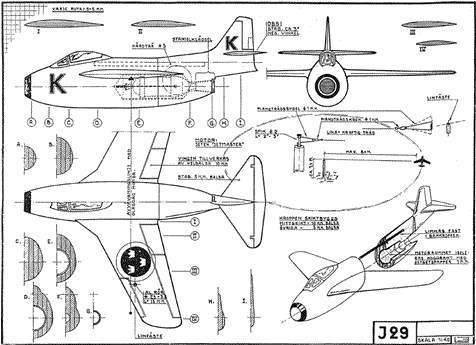 Thirdly, confirming that Jetex RTP was popular in many countries, John Miller Crawford found an article by André Dautin, ‘Le vol circulaire avec Jetex’, in Le Modèle Réduit d'Avion, May 1953. Monsieur Dautin was a well known jet modeller, and his 1954 Convair XF-102 was one of the first (and best) independent designs for the Jetmaster/augmenter tube combination, so I look forward to sharing this RTP article with readers before too long. |
 |
||||||||||||||||||||||||||||||||||||||||||||
|
Lastly, as if all of the above wasn’t enough, Mick Parker sent me a fascinating chapter from his Boy’s Book of Flight (1954). ‘How to build and Fly Your Own Jet’ is a good example of the irresponsible though possibly envisioning aeromodelling journalism of those days. The jet in question is a most attractive RTP papier mâché and balsa wood Supermarine Swift [right], powered by an enclosed Jetex 50 firing into ‘a thin aluminium or metal (?) foil tube’. The text is nicely illustrated, but the instructions are inconsistent and woefully inadequate at many points. Though we are assured; “no particular skill is needed … exercise care and patience, … this article and the sketches give you all the information you require even if you have never made a model aircraft”, I am not convinced that many boys could have tackled this project successfully without assistance. |
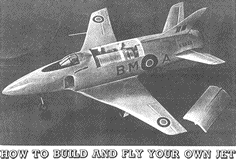
- Boy’s Book of Flight, 1954
|
||||||||||||||||||||||||||||||||||||||||||||

 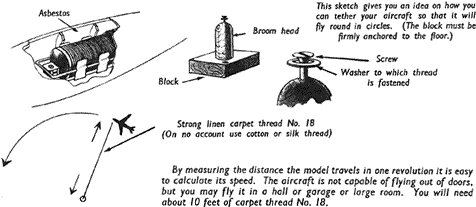 I continue to be amazed at these sorts of articles, which so blithely and disingenuously presume too much on the reader’s skills. I’m only glad I didn’t see this one at the time, as it would have reinforced my massive modelling inferiority complex. I think I might just about be capable of this model now, and I quite fancy playing with glue and wet newspaper. But something tells me I should never, ever, put the mould in the fridge. |
|

- Boy’s Book of Flight , 1954 (p. 70)
|
|||||||||||||||||||||||||||||||||||||||||||
|
|
|||||||||||||||||||||||||||||||||||||||||||||
|
|
|
||||||||||||||||||||||||||||||||||||||||||||
|
|
|
|
|
|
|
|
Acknowledgements - Article: Roger Simmonds - Illustrations: Roger Simmonds (LSARA glider, F.D.2, DH.108, Jetex 200 Contest Model, Mansout RTP, SAAB J29 ) Ian Dowsett (Star-Jet plan) Mick Parker (RTP Swift) |
|
|
|
|
ABOUT | MOTORS | MODELS | ARCHIVE | HISTORY | STORE | FAQ | LINKS |
|
|
Terms of Use
|
Queries? Corrections? Additions?
Please
contact us.
|
|